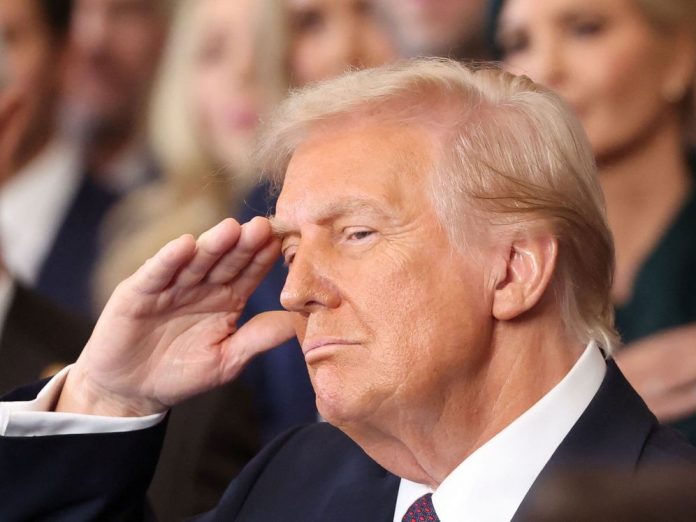Allegations that Trump is a Russian asset are preposterous, especially given his strong anti-Russia stance during his first presidency.
Rather than accusing him of being pro-Russia, critics should listen carefully to what he is actually saying: he wants the Ukraine war to end, with people stopping the killing, and for the U.S. to stop financing it.
He has even offered Ukraine a peace deal that includes minerals for defense and guarantees Ukraine’s security without requiring the country to join NATO, which would address Putin’s primary concern regarding Ukraine.
During his first term, President Donald Trump adopted several policies that were tough on Russia, despite his more conciliatory rhetoric towards President Vladimir Putin.
Between 2017 and 2019, the Trump administration took 52 actions, including sanctions, military assistance, and diplomatic measures, all targeting Russia’s malign activities.
These actions were primarily a response to Russia’s interference in the 2016 U.S. elections, its involvement in Ukraine, and its use of chemical weapons in the UK.
In 2018, for instance, the administration-imposed sanctions on Russian individuals and entities tied to election interference, cyberattacks, and the poisoning of former spy Sergei Skripal.
Additionally, the U.S. expelled Russian diplomats and imposed export restrictions following Russia’s violation of the Intermediate-Range Nuclear Forces (INF) Treaty.
Military measures were also a key part of the strategy. The U.S. provided Ukraine with defensive weapons to counter Russian-backed separatists and sanctioned Russia’s military and intelligence sectors.
In response to the Skripal poisoning, the administration imposed further sanctions under the Chemical and Biological Weapons Control and Warfare Elimination Act.
It also approved lethal weapons sales to Ukraine, reaffirmed the U.S. rejection of Crimea’s annexation, and bolstered Ukraine’s naval capabilities.
Beyond these actions, the Trump administration took additional steps to limit Russia’s influence, such as banning the use of Kaspersky Labs software on government computers due to its ties to Russian intelligence.
It also released the “Russian Oligarch List” and continued imposing sanctions under the Countering America’s Adversaries Through Sanctions Act (CAATSA), targeting Russian elites and companies involved in illicit activities.
Despite Trump’s amicable interactions with Putin, these policies demonstrate a firm stance against Russian aggression and interference in international affairs.
The 2017 Countering America’s Adversaries Through Sanctions Act (CAATSA) mandated sanctions on Russian individuals, companies, and officials involved in these activities.
Despite some delays in enforcement, sanctions were ultimately imposed, with the Trump administration gradually adding more names to the list. These measures targeted Russian oligarchs and government officials connected to Putin’s inner circle.
In 2018, following the poisoning of former Russian spy Sergei Skripal in the UK, the Trump administration expelled 60 Russian diplomats and closed Russia’s consulate in Seattle as part of a coordinated international response.
The U.S. also imposed sanctions on Russian energy companies, including those involved in the Nord Stream 2 pipeline project, which was seen as a major effort by Russia to bypass Ukraine and extend its influence in Europe.
Sanctions were also levied against Rosneft Trading, a subsidiary of the Russian oil giant, for its dealings with Venezuelan oil.
Alongside these sanctions, military actions were also taken.
The Trump administration authorized the sale of lethal weapons to Ukraine, including Javelin anti-tank missiles, marking a significant departure from previous U.S. policy under the Obama administration.
This move was seen as a direct challenge to Russian influence in Ukraine and aimed to strengthen Ukraine’s defenses against Russian-backed separatists.
The Trump administration took several steps to deter Russian interference in future U.S. elections.
The Cybersecurity and Infrastructure Security Agency (CISA) worked to bolster U.S. election infrastructure defenses against cyberattacks, particularly from Russian actors.
This included attributing several major cyberattacks to Russian state-backed hackers, such as the SolarWinds hack in 2020.
In addition, Trump approved the deployment of thousands of U.S. troops to Eastern European NATO allies, including Poland and the Baltic states, as part of NATO’s broader deterrence strategy against Russian aggression.
Following the 2018 poisoning of Sergei Skripal and his daughter in the UK, the U.S. joined the UK and other allies in expelling over 150 Russian diplomats in a coordinated diplomatic protest.
The administration also indicted several Russian individuals for cyberattacks and election interference, including members of Russia’s GRU (military intelligence) and the Internet Research Agency.
The Department of Justice and FBI pursued aggressive investigations into Russian interference in the 2016 election, culminating in special counsel Robert Mueller’s investigation, which resulted in multiple indictments of Russian individuals and entities.
Despite Trump’s often criticized diplomacy toward Putin, these actions reflect a series of policies that were, in practice, hostile toward Russia—especially in terms of economic sanctions, military support for Ukraine, and efforts to curb Russian activities both in the U.S. and internationally.
The post Far From a Kremlin Stooge, Trump’s Real Record on Russia appeared first on The Gateway Pundit.
This article may have been paraphrased or summarized for brevity. The original article may be accessed here: Read Source Article.





![President Trump Gives Barron A Shout Out At Inaugural Parade: His Unexpected Response is Pure Gold! [VIDEO] president-trump-gives-barron-a-shout-out-at-inaugural-parade:-his-unexpected-response-is-pure-gold!-[video]](https://news.lateawakening.com/wp-content/uploads/2025/01/35545-president-trump-gives-barron-a-shout-out-at-inaugural-parade-his-unexpected-response-is-pure-gold-video-100x70.jpg)



